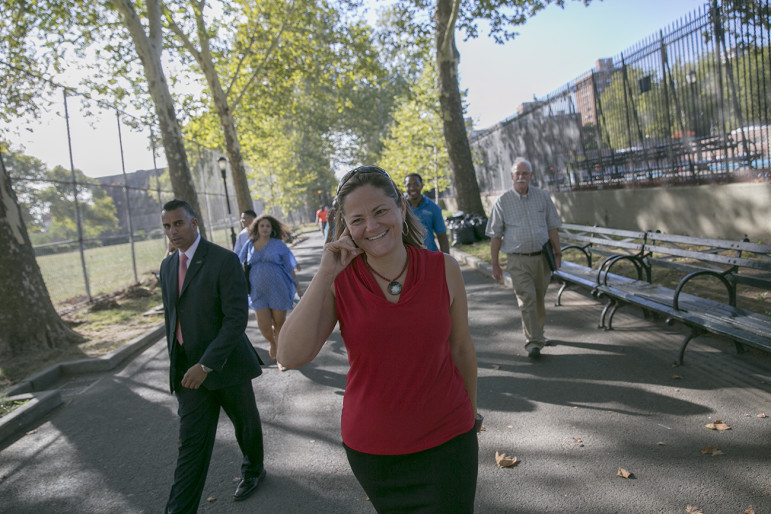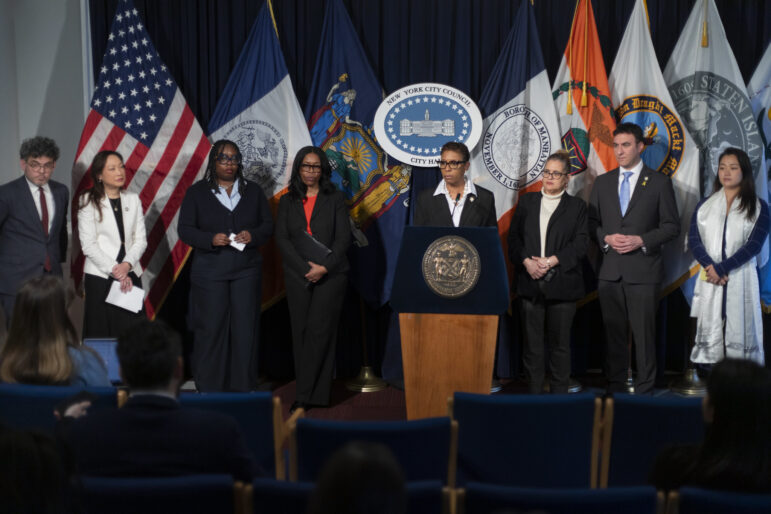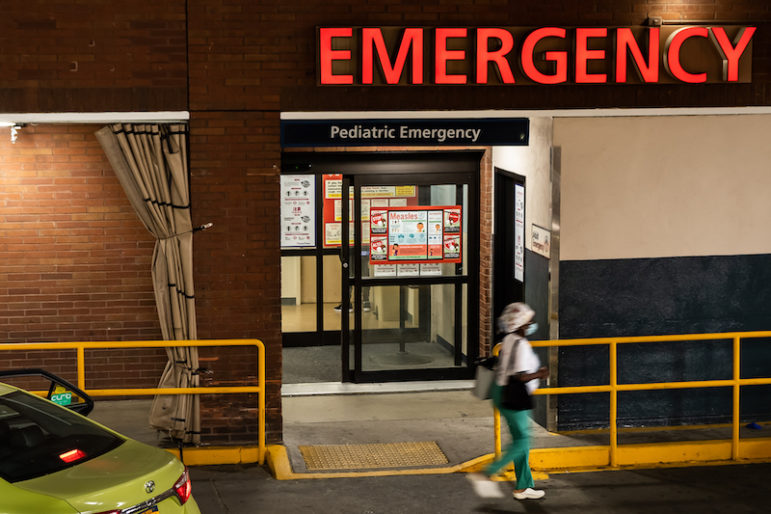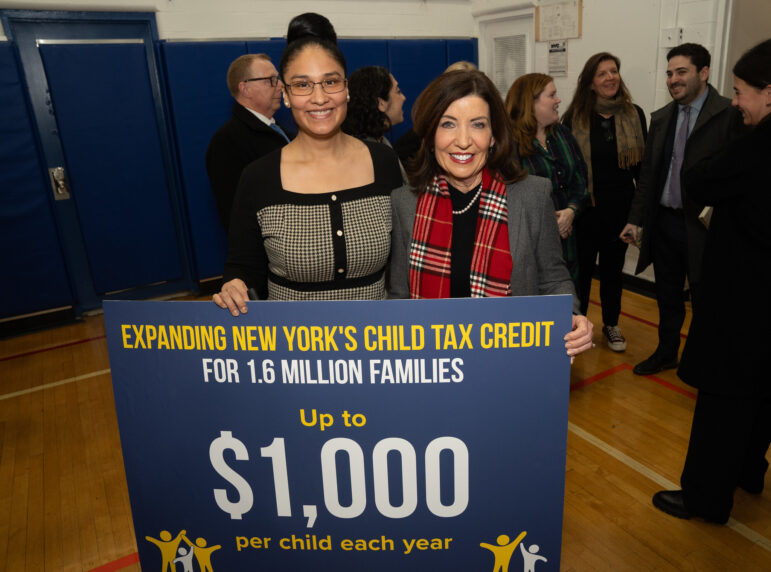
William Alatriste for the New York City Council
Speaker Melissa Mark-Viverito seen in East Harlem in August 2014. She supports the mayor's rezoning proposals but the community planning effort she has spearheaded includes groups that don't.
Over 500 surveys. Seven public meetings each with 100 to 200 participants. 12 subtopics—from open space and small businesses to zoning and housing preservation.
Since April, many East Harlem organizations and residents have been immersed in an intensive process called the East Harlem Neighborhood Planning and Rezoning. Launched by City Council Speaker Melissa Mark-Viverito, the goal is to craft a plan that will create new educational and economic opportunities for the residents of East Harlem, as well as preserve the neighborhood’s distinct community and culture. The draft plan will be released in late January and a public hearing will be held to solicit residents’ feedback. The revised, final plan will be provided to the Department of City Planning (DCP), offering a roadmap to influence the city’s potential rezoning of the neighborhood.
East Harlem is among the first seven* neighborhoods that Mayor de Blasio has said he hopes to upzone in order to reach his goal of creating and preserving 200,000 units of affordable housing. The city’s rezoning application for the very first neighborhood, East New York, has proven contentious, with community boards voting against the proposal and Comptroller Scott Stringer warning the plan would put nearly 50,000 residents at risk of displacement.
The East Harlem Neighborhood Plan is not without its critics—including those who felt the format of the public sessions limited meaningful resident input, that the steering committee should be more transparent about what goes on at non-public meetings, and that the speaker sold out by agreeing to the concept of a rezoning at all. Yet the process, with all its imperfections, is certainly a new take on collaboration between government officials and community members.
“There is no template,” says Betsy MacLean, the executive director of Hester Street Collaborative, a non-profit specializing in urban planning that has helped to facilitate the process. “We’re making this up as we go.”
Critiques of the process aside, the question remains whether City Hall will adopt the plan. Organizers of the planning process are hopeful. Representatives from a variety of agencies have attended meetings to explain what recommendations are likely feasible, and which not.
“We’re really trying to connect with the city agencies to make sure this work has legs and can be implemented,” said George Sarkissian, the City Council’s Deputy Director of Economic and Community Development and a representative for Mark-Viverito, at a recent Community Board 11 meeting. He added that the city has created a Neighborhood Development Fund for improvements in communities undergoing a rezoning, and that the plan would rely on both the fund and on agencies’ budgets to finance the recommendations. He also stressed that the plan’s implementation would require strong community support.
Officials at DCP also say they are very interested in the results of the process. Yet asked how DCP will mesh all the material they get with a potential rezoning, DCP Press Secretary Rachaele Raynoff says that without the plan yet complete, it is too early too comment. “We look forward to seeing the results of the speaker’s process,” she says.
A mix of voices
Other neighborhoods targeted by the de Blasio rezonings have also taken action to shape the future of their communities. In East New York and at another site along the Jerome Avenue in the Bronx, residents and community advocates have organized forums of their own outside of official planning meetings.
East New Yorkers, feeling DCP officials were not taking their comments seriously and eager to craft a plan on their own terms, organized the Coalition for the Advancement of East New York and Cypress Hills, which proposed an alternative plan with deeper levels of affordability than the city’s proposal.
In the Jerome Avenue area, nonprofits, faith groups and other stakeholders, frustrated that the first DCP meetings were open only to a limited number of invited groups, held a public meeting to brief neighborhood residents about the plan. They formed the Bronx Coalition for Community Vision, which crafted a policy platform to inform the rezoning of Jerome Avenue.
In Harlem, the process has been different, and the border between “official” and “grassroots” not as clearly defined. DCP put their own study on hold when Mark-Viverito, a powerhouse and ally to the mayor who has endorsed his mandatory inclusionary housing policy, came up with the idea for the neighborhood planning process. All the organizations on the steering committee participate at her invitation.
Yet the project is also co-organized by the neighborhood-based social justice organization Community Voices Heard, which has voiced opposition to the mayor’s Mandatory Inclusionary Housing (MIH) proposal, as well as Community Board 11 and Borough President Gale Brewer. CB11 and Brewer’s Borough Board voted “no” on the MIH proposal with conditions. (Brewer last week agreed to support the proposal after the administration agreed to address a range of concerns). Furthermore, organizers of the forum stress that the recommendations in the plan will be based on the ideas of residents who have attended workshops and meetings.
“When we talk about community engagement, this is real community engagement,” says Ethel Velez, a NYCHA Tenant Association leader from Johnson Houses. “I think this is remarkable, something that was never done before.”
A plan for everything, eventually
The steering committee has already voted to approve recommendations for seven of the 12 topic areas being explored. Those for youth and economic development were presented at community board meetings this month. Recommendations for the remaining categories (housing, zoning, the environment and transportation, safety, health and seniors, and overlapping recommendations that involve multiple categories) will be voted on in the next couple weeks.
So far, the plan proposes the creation of more community schools, which can be new or existing schools that are given additional resources to provide on-site social services and create partnerships with community-based organizations. It also recommends more Career and Technical Education programs, an expansion of the universal prekindergarten initiative to include day care for children ages zero to three, and infrastructure improvements for day-care and after school facilities, among other ideas.
As for economic development, the plan calls for requiring developers seeking rezoning approvals to provide public quarterly reports on local hiring. It recommends additional funding to support neighborhood-based workforce training organizations, the establishment of a local Workforce-1 center, zoning amendments to encourage commercial development and preclude big-box stores, and the potential creation of a Business Improvement District.
While the recommendations for other topics have not yet been presented, early proposal drafts, composed prior to an official vote, can be viewed at the plan’s website.
Proposals include everything from the use of green infrastructure to protect East Harlem from flooding, to the formation of a new arts advocacy organization to promote cultural activities in the neighborhood.
The plan for housing preservation includes taxes on landlords who “warehouse” properties, or keep them vacant so they can be sold at a higher price, regulations to support the development of more affordable housing using air rights transfers, and the placement of vacant land and distressed buildings in a community land trust.
A key recommendation listed for NYCHA is to make sure that if there is any infill development, a clear governance structure is established to give residents a say in the design and affordability of the new structures, and any revenue generated through development is spent on adjacent buildings.
While the recommendations for affordable housing development and zoning subgroups have yet to emerge, participants on the steering committee generally agree that something needs to be built—and at more generous levels of affordability than the mayor’s plan. The 111th street ball fields and community gardens, the Park Avenue viaduct, NYCHA open space, and East 125th street have all been discussed as potential sites for development.
On multiple occasions in the past, Community Board 11 has endorsed a 20-30-50 model, with 20 percent of housing for low-income families, 30 percent for middle-income and the rest market-rate. WXY, an urban planning firm assisting with the planning, is in the process of modeling a variety of zoning and affordability scenarios for the steering committee.
In the end, it is likely that the steering committee will have to sort out a number of conflicting priorities, especially the need for affordable housing and open space. Velez, leader of the NYCHA subgroup, has already professed her desire to leave NYCHA infill development out of the plan, or at the very least, to reserve infill development for low-income and senior housing. The mayor has proposed building a mix of 50 percent market-rate and 100 percent affordable buildings on NYCHA property to generate money for repairs in existing NYCHA buildings.
“I understand that folks talk about the need for money, but this is not the answer,” says Velez.
Balancing speed with inclusiveness
Neighborhood-based planning can often be a lengthy process: the Chinatown Working Group took six years to craft their zoning and housing plan. The East Harlem Neighborhood Plan, however, will be completed in less than a year, and that’s already a couple months behind its original schedule. Planners have grappled with strict deadlines. According to MacLean at Hester Street Collaborative, the neighborhood is under pressure from City Hall, which is eager to meet its housing goals, and the speaker is also anxious to get a plan in action before she reaches her term limit in 2018.
The fast pace can be in part credited to a clear source of funding for professional assistance and an elaborate system of rules delegating tasks to smaller bodies for each phase of the process. WXY received $92,000 from the New York City Economic Development Corporation to assist with the project, and Community Voices Heard and Hester Street Collaborative are both receiving smaller, undisclosed amounts from the Neighborhoods First Fund for Community Based Planning. The fund, formed last spring with the mission of helping communities create nuanced responses to the mayor’s rezoning proposals, includes DeutscheBank, the Ford Foundation, M&T Bank, the Mertz Gilmore Foundation, the New York Community Trust, the New York Foundation, the Scherman Foundation, and the Surdna Foundation.
While WXY and Hester Street Collaborative facilitate the process and provide access to data, it is up to the 21 organizations on the steering committee to decide on recommendations. These organizations, appointed by the speaker, are supposed to represent a cross-section of “local leaders and organizations with a rich history of serving the community.” While most are neighborhood-based groups, some are citywide organizations with projects in East Harlem, like the community gardens nonprofit New York Restoration Project, which has come under criticism in East Harlem for selling air rights to a market-rate housing developer in order to expand community garden space.
The speaker also appointed organizations on the steering committee to serve as leaders for 12 subgroups, each focused on a different topic. Subgroup meetings are attended not only by steering committee members, but by other organizations that have asked to join—organizers say none have been turned away—or that have been invited by the subgroup leaders.
Each subgroup was responsible for hosting a public forum on its designated topics. The public forums, which offered free childcare and Spanish translation, often took a similar format: a presentation by the subgroup leader, followed by small group work at tables, and closing with “report backs” from each table. Subgroups were then charged with taking the public’s ideas and translating them into concrete recommendations, which were revised with the input of steering committee members and city agencies. (A CVH video about the planning process can be viewed here.)
Room for better community engagement?
John Medina, a longtime resident and member of Community Voices Heard, says he was impressed by the level of resident involvement in the planning process.
“It’s the first time I’ve seen community engagement to this level,” he says.
Others, however, would have liked to see different types of outreach. Community Board 11 member Marie Winfield said at a recent board meeting she wished there had been greater youth involvement in the education and day-care subgroups. Barbara Carrion, another resident and member of Community Voices Heard, was concerned that some people who came to the meetings were new to the process of urban planning, making it a challenge to craft meaningful recommendations from public visioning sessions. She thought more time should have been spent preparing residents for the in-depth subject matter. She added that some of the basic prompts asked by workshop leaders like “what do you love about East Harlem?” didn’t get to the immediate issues at hand.
“We already know what we love and what we don’t,” she said. “It would have been much better served to really discuss the subject matter…and maybe [offer] a little more history on the subject, and the legality of issues related to the subject matter.”
Others questioned the independence of the steering committee members, noting that many receive support from Mark-Viverito’s discretionary funds, or feared that steering committee members would craft plans that reflected their own interests, not the feedback collected from the public visioning sessions. Critics called for greater transparency about who was involved in each subgroup and what took place at subgroup and steering committee meetings.
Local writer and filmmaker Andrew Padilla says the format of the public visioning sessions—presentations followed by small group work—didn’t give participants an opportunity to express their true opinions, and that he would have preferred an open mic. He feared that Mark-Viverito and City Hall would use the plan to pursue an upzoning that would displace residents in exchange for neighborhood improvements.
“There have been so many other things brought into these rezoning conversations to make it seem like the way to get better schools and better transportation is to go through this process,” he says. “We can attain all of those things without upzoning the neighborhood.”
For others, linking neighborhood improvements to a rezoning was a practical step.
“If you don’t rezone, then what?” says Diane Collier, chair of community board 11. “You try to work within the system to get what you want.”
Admitting Imperfections
MacLean of Hester Street Collaborative says they’d held multiple workshops on zoning to help residents gain knowledge of technical subjects in response to complaints about a lack of background. Yet she admitted that the steering committee has been “struggling to talk more about rezoning in a very specific way” in large community settings and that they could get better at “getting community-based ideas out of these workshops.”
MacLean says that if they had to do it over, she would have taken additional steps to make the planning process more transparent. The steering committee already plans to record all future meetings and post the recordings online.
The lead organizers also recognize that the public is eager to see how their thoughts have translated into recommendations. This is the reason the steering committee is organizing additional presentations, sharing portions of the draft plan at Community Board 11 subcommittee meetings throughout December and January, to give the public more opportunities to comment ahead of the full release in late January.
“Let’s respond to the feeling that people may not know what happened to their ideas since each thematic visioning workshop, and let’s hear how people think we’re doing at putting their ideas into recommendations,” says Sondra Youdelman, director of Community Voices Heard.

Demetrius Freeman/City Hall
Click here to tead our continuing coverage of the mayor's rezoning efforts.
Amy Varghese, representing Mark-Viverito, says that while it was true many groups on the steering committee receive discretionary funds from the speaker, that the proposals will be based on feedback generated directly from the public.
Though she recognizes room for improvement, MacLean ultimately believes the process is far more rooted in a community vision than the Department of City Planning’s current neighborhood planning strategy, which also includes public visioning sessions by topic, but lets the agencies write the plans. She hopes that DCP can learn from the East Harlem Neighborhood Planning and Zoning process to institute grassroots planning citywide.
“Hopefully the East New York experience is a rude awakening and this process is instructive, even if we can just get a little kernel out of this—if City Planning can think twice about the way they do planning.”
* Correction: The first version of this article said only four neighborhoods have been targeted for rezoning.
City Limits’ coverage of housing and development is generously supported by the Charles H. Revson Foundation.









4 thoughts on “Will the City’s Rezoning Plan for East Harlem Heed Community’s Vision?”
“Critics aside????” What a farce of a report. It would take millions of dollars and dozens of city employees to ensure that these “asks” (wishes) will be monitored, let alone enforced. This was a huge waste of the community’s valuable time and energy. Sham! Shameless!
Although the community boards and non-profits may offer some good advice, there are several proposals which shouldn’t be considered by the city. In Brooklyn, the Coalition for the Advancement of East New York and Cypress Hills suggests reducing street cleaning and restricted parking for example. which is contrary to city and metropolitan goals.
The boards typically only view things through the contexts of the neighborhood.
Very disappointed by the format and “inclusive” nature of the Mayor’s “Exclusive” plan. Sadly CB11 Chair copulates to an elusive negotiation without even being strong armed to favor an “as of yet” “compromise”. What a sham, These means will not be justified in the end- MMV has established her tyranny and the masses will revolt. The two faced administrative directives have resulted in two separate press conferences where East Harlem Gardens were announced to be protected, yet “unprotected”… Mama mia! There is a rose that grows in Spanish Harlem!
Pingback: Proposed Rezoning likely to bring changes to Staten Island – Pavement Pieces